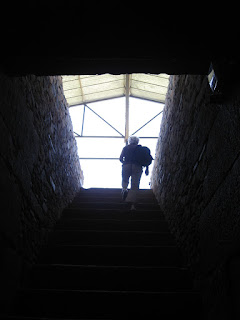Set on a small hill 1.8km northeast of the Northern Stelae Field and offering views of the jagged mountains of Adwa are these two tombs that local tradition attributes to the 6th-century King Kaleb and his son, King Gebre Meskel. Although the twin tombs’ architecture resembles the Tomb of the False Door, they show more sophistication, using irregular-shaped, self-locking stones that don’t require iron clamps.
The Gebre Meskel (south) tomb is the most refined. The precision of the joints between its stones is at a level unseen anywhere else in Aksum. The tomb consists of one chamber and five rooms, with one boasting an exceptionally finely carved portal leading into it. Inside that room are three sarcophagi, one adorned with a cross similar to Christian crosses found on Aksumite coins. This points towards an age around the 6th century AD, which, as seldom happens, corresponds with local tradition…though the rest of the story has Meskel buried at Debre Damo.
Like Meskel’s tomb, King Kaleb’s is accessed via a long straight stairway. Inside you’ll notice the stones are larger, more angular and less precisely joined. Of those who attribute the making of the tomb to Kaleb, few accept that he was actually buried here. The common theory is that his body lies at Abba Pentalewon monastery, where he lived after abdicating his throne. The tomb’s unfinished state fits with the theory. Local rumour has it that there’s a secret tunnel leading from here to the Red Sea.
Source: Tombs of Kings Kaleb & Gebre Meskel - LonelyPlanet.com
The Gebre Meskel (south) tomb is the most refined. The precision of the joints between its stones is at a level unseen anywhere else in Aksum. The tomb consists of one chamber and five rooms, with one boasting an exceptionally finely carved portal leading into it. Inside that room are three sarcophagi, one adorned with a cross similar to Christian crosses found on Aksumite coins. This points towards an age around the 6th century AD, which, as seldom happens, corresponds with local tradition…though the rest of the story has Meskel buried at Debre Damo.
Like Meskel’s tomb, King Kaleb’s is accessed via a long straight stairway. Inside you’ll notice the stones are larger, more angular and less precisely joined. Of those who attribute the making of the tomb to Kaleb, few accept that he was actually buried here. The common theory is that his body lies at Abba Pentalewon monastery, where he lived after abdicating his throne. The tomb’s unfinished state fits with the theory. Local rumour has it that there’s a secret tunnel leading from here to the Red Sea.
Source: Tombs of Kings Kaleb & Gebre Meskel - LonelyPlanet.com













